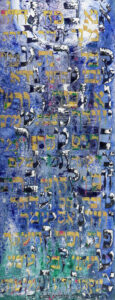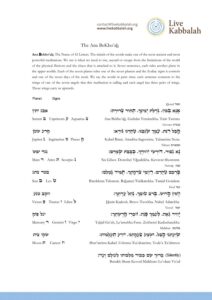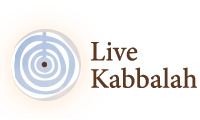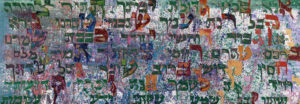The prayer ‘Ana BeKho’aḥ‘ is based on what is known among Kabbalists as ‘The Name of 42 Letters’, this powerful combination of letters in famous for its holiness, and is known to give the ability to overcome obstacles and judgments, the illusion of matter and the limitations of logic.
Sources and Meaning
The prayer known as ‘Ana BeKho’aḥ’ is attributed to the rabbinic sage Rabbi Nehunia Ben Hakana, known also as the author of Sefer Hakana, one of the earliest Books on Kabbalah (1st century CE). Like many prayers in the Siddur, this prayer is named after its first two words. This important prayer has seven verses and is sealed by the eighth line Barukh shem kevod malkhuto le’olam va’ed (Blessed is His glorious name His kingdom is forever) that is also used after the first line of the Shema Yisrael prayer.
This Hebrew prayer appears in every Siddur (Prayer Book) in many places:
- In the beginning of Shaḥarit, the morning prayer- in the section that recites the Morning Temple Offerings (Korbanot)
- In Kabbalat Shabbat (welcoming the Sabbath) before the song Lekha Dodi.
- In the Bedtime Shema
- It is recited during the funeral service.
The Name of 42 Letters
Each of the 7 verses of the “Ana BeKho’aḥ” prayer has 6 words. That 42 letter sequence is made up from the first letter of each word (acrostic) of the prayer and comprises what is known in Kabbalah as ‘The Name of 42 Letters’, one of the most important names of the Creator.
Rabbi Neḥunia Ben Hakana, like other rabbinic sages in his era, 1st – 3rdCentury CE, feared the potential loss of knowledge and secrets of the Torah (seeing the exile and The Dark Ages coming) and sought to preseve it for future generations. This was the reason that Our Sages wrote down the Mishna, the Zohar and, afterwards, the Talmud. The prayer “Ana BeKho’aḥ” was a way of encoding and hiding The Name of 42 Letters in the Siddur, (prayer book). Until this day few know the secret of this prayer.
The Acrostic – the sequence of the first letter of each word of each of the 7 verses appears in many prayer books alongside its corresponding line.
According to the Zohar one reads the words in pairs while also concentrating on the first letters (initials) in pairs. This is because every combination of 6 initials (first letters of each word of a line) corresponds to the 6 wings of the Seraphim (Angels, Isaiah 6:20), and the wings of the Seraphim are placed in pairs. The purpose of this prayer, in principle, is to elevate our mundane world and our mundane, limited consciousness (Malkhut, Asiya) to higher levels.
Origin of ‘The Name of 42 Letters’
The Name of 42 Letters existed from the dawn of creation and is encrypted in the first 42 letters of the story of creation in Genesis, from the Bet (the first letter in the Torah) of Beresheet until the letter bet of Vavohu. A complex mathematical formula transforms the first 42 letters of Genesis into the holy Name of 42.
The Powers of ‘The Name of 42 Letters’
The power of the ‘Name of 42’ endows the user with the ability to transcend from the illusions and limitations of physicality with its’ emptiness, and the restrictions that are associated with our reality. These limitations force us to have to make an effort to elevate above them in order to connect to true spirituality. Usage of this name is essential to the process of spiritual elevation.
Because of the Kavana (meditation, meaning and intention) of this holy name, the times to recite it are:
- Shaḥarit – The Morning Prayer, after reciting the Korbanot (temple offerings) in order to allow elevation to the upper realms or worlds in the beginning of this important morning connection.
- Friday night, before Lekha Dodi. At this time the worlds ascend and we need this prayer to help us ascend to Shabbat
- Sephirat Ha’Omer – The Counting of The Omer.
- Bed Time Shema – before going to bed, in order to support the soul who needs to ascend to the place of quarry or well of souls (according to the Tikunei HaZohar)
- Before a person departs this world, when a person feels that his time to depart has come, after the Vidui (confession & confirmation).
- During the funeral service, in order to help the deceased to elevate to the upper worlds.
- Any time there’s a need to elevate above the confusion and stress of daily struggle.
The most common way Kabbalists meditate on the ‘Name of 42’ is by contemplating on the 6 initials formed from the first letter of each word of each of the seven verses.
Each sequence of the 7 acrostics of the seven verses of the Ana BeKho’aḥ has the ability to connect us to one Sephira or a spiritual dimension above the illusionary and physical world. Using each permutation is like a secret password that enables us to access the treasure chamber in the upper worlds filled with light, power, energy and wisdom.
According to the wisdom of Kabbalah each one of the seven sequences controls a range of aspects of our reality. The seven Sephirot are expressed in the material world in many forms, for example, the spiritual dimensions that control each of the seven planets or one of the seven days of the week.
It is written in the Gate of Meditations (Sha’ar HaKavanot), of the Writings of the ARI, the holy ARI of Tsfat (Safed), that without the prayer Ana BeKho’aḥ, one would not be able to elevate from the physical world and ascend to higher levels of meditation or prayer. Therefore it is worthwhile to recite the ‘Ana BeKho’aḥ’ every morning before we start our daily actions. Because of its great importance, ‘The Name of 42’, the Ana BeKho’aḥ, is encoded in every important prayer in the Hebrew Prayer Book, and through this we are allowed to elevate to much higher spiritual levels and to control the channels of abundance that are so important for the success of our lives. ‘Success’ is achieved when we experience a flow of abundance and good fortune, meaning a manifestation of ongoing flow of spiritual energy from the higher worlds to all aspects of our lives, both material and physical.
The power of exercising this prayer/meditation, the Ana BeKho’aḥ, every morning, according to the teachings of the holy Ari, is to elevate us up and above the illusory physical world, above our limited perceptions (thinking within the box) and above our limited and used up belief systems. The result will be newly acquired abilities to break through and to reach higher levels of consciousness that will result in more elevated ways of experiencing our reality and a higher awareness – different and more fulfilling.
It is possible to use this prayer during the day without limit, not only in the beginning of the day. It can be used before any important task, when a challenging problem appears or at any time there’s a need to connect to higher, more elevated levels (worlds). Connecting to the higher worlds where an abundance of wisdom and life force is flowing is what allows us to change and grow in quantum leaps. The Ana BeKho’aḥ prayer helps us to open up (and receive) the bliss that is needed in order to achieve true positive change.
Throughout the generations, the Ana BeKho’aḥ prayer was very important to the Kabbalists who knew how to use the enormous power of the holy and powerful letters’ combinations in order to improve their destiny, to elevate beyond the restrictions of logic and to fulfill the soul. Therefore it is possible to find the Ana BeKho’aḥ and its letter combinations, the ‘Name of 42’, on the walls of many old synagogues.
 Kavana (meaning, meditation & intention) of the seven letter combination of the Ana BeKho’aḥ Prayer:
Kavana (meaning, meditation & intention) of the seven letter combination of the Ana BeKho’aḥ Prayer:
The first verse, Ḥesed:
אנא בכח. גדולת ימינך. תתיר צרורה: אבג יתץ
This verse connects us to the Sephira of Ḥesed (Loving-Kindness), the first of the seven Sephirot (of Ze’ir Anpin). The Sephira of Ḥesed represents the power of unconditional love, compassion and sharing. The numerical value of the acrostics of the words of this first verse אבג יתץ (506) equals אהבת חנם – unconditional love. According to the Kabbalists, this verse has the power of all the other verses combined, and it connects us directly to the frequency of Ets Ḥaim עץ חיים The Tree of Life, a parallel universe where all are one, before the Fall of Adam, before the breaking of the world of unity. This is a reality of truth without the limitations of physicality, and without obstructions created by negative energy. By contemplating and meditating on this sequence of אבג יתץ we are connected to a reality of completion, true unity, and truth. Connection to this frequency focuses us on our true spiritual work. This sequence gives us the power to overcome the illusion of the limitations of space and time.
According to the Zohar this combination controls the cosmic window, among other things, to the planet Saturn and the zodiac signs of Capricorn and Aquarius (both controlled by Saturn).
The Second Verse, Gevura:
קבל רנת. עמך שגבנו. טהרנו נורא: קרע שטן
This verse connects to the Sephira of Gevura. The acrostics of the words of this verse are: קרע שטן. The power of this verse according to the ARI is to return to the state of perfection of the spiritual worlds that were torn and descended into the lower worlds. The power to tear up and cancel the illusion of Satan (negative) Consciousness in ourselves and to cancel or sweeten the judgments; the desire to receive for oneself alone, and all the judgments experienced by way of our anger, hatred or other negative, selfish emotions. We use this combination during the sounding of the Shofar on Rosh Hashana to cancel all the judgments according to the holy ARI. The numeric value of the letters קרע שטן equals that of the word תשכח Tishkaḥ (728), to forget. We use this combination with the intention that we want to forget the limitations that the Satan Consciousness binds us to, limiting us by having the false belief that we are not able to overcome the limitations we are facing.
According to the Zohar this controls the cosmic window, among other things, to control the planet Jupiter and the zodiac signs of Sagittarius and Pisces.
The Third Verse, Tiferet:
נא גיבור. דורשי יחודך. כבבת שמרם : נגד יכש
This verse connects to the Sephira of Tiferet.
The acrostics of the words of this verse are: נגד יכש
There are two permutations in this sequence:
- 1. נגד has the numeric value of the word Zan (57). The number 57 represents spiritual abundance, and worldly livelihood. This combination signifies that the abundance will only flow into our lives when we resist our innate nature to take for ourselves alone. Only when we resist the sefishness and transform it to caring and sharing will we open and connect to the flow of abundance in all our actions.
- 2. יכשappears in the verse מי שמך לאיש (Who made you our judge?). Moses used this combination in the Torah (Exodus 2:14) to kill the Egyptian, and its power is to take out of any living being the good sparks and light contained within their Klippot ( negative forces), in order that there not remain any life force for the evil within. In this situation the evil will wither and die and then the energy of life can be restored. This combination is able to help us renew and return ourselves to a pure, embryonic, state.
According to the Zohar this permutation controls the cosmic window, among other things to the planet Mars which controls the zodiac signs of Aries and Scorpio.
The fourth verse, Netsaḥ:
ברכם טהרם. רחמי צדקתך. תמיד גמלם. בטר צתג
This verse connects to the Sephira of Netsaḥ.
The acrostics of the words of this verse are: בטר צתג.
From this verse we receive the spiritual ability to draw vision, confidence and certainty that are the prerequisite for true victory. This power enables us to rise up after we have stumbled, to finish what we started, to work vigorously, to overcome obstacles and remove all doubt in order to complete the most difficult tasks.
According to the Zohar, this permutation controls the cosmic window to the Sun, among other things, which controls the zodiac sign of Leo.
The fifth verse:
חסין קדוש. ברב טובך. נהל עדתך. חקב טנע
This verse connects to Sephira Hod.
The acrostics of the words of this verse are: חקב טנע.
This verse helps us in asking to see the secrets of the universe and the truth above logic and the five senses.
According to the Zohar this permutation controls the cosmic window to the planet Venus, among other things, which controls the zodiac signs of Taurus and Virgo.
The sixth verse:
יחיד גאה. לעמך פנה. זוכרי קדושתך. יגל פזק
This verse connects to the Sephira of Yesod.
The acrostics of the words of this verse are: יגל פזק.
The numerical value of these six letters is 230 ירך (– thigh, hip). This is the name for victory in every battle of life (The Book of Root of Names, Rabbi Moshe Zakut).
“This name reveals the Bliss that is coming through the Yesod, therefore, this name should be used in order to reveal the wisdom in the 6th millennium”. (Adir BaMarom, Rabbi Moshe Haim Luzzatto)
According to the Zohar this permutation controls the cosmic window to the planet Mercury, among other things, which controls the zodiac signs of Gemini and Virgo.
The seventh verse:
שוועתנו קבל. ושמע צעקתנו. יודע תעלומות. שקו צית
This verse connects to the Sephira Malkhut.
The acrostics of the words of this verse are: שקו צית.
This permutation connects to the treasure of endless fulfillment which is waiting for us in the final days. Connecting to this name gives us unlimited power in times when we are weak and empty.
According to the Zohar this permutation controls the cosmic window to the Moon, among other things, which contols the sign of Cancer.
After completing all seven verses,
ברוך שם כבוד מלכותו לעולם ועד
‘Barukh Shem Kevod Malkhuto LeOlam Va’ed’
is said in order to embody (seal) the prayer since this is one of the holy names of the Creator (just like the priests and the people were saying in The Temple in Yom Kippur after each time The Holy Name was heard). This last line is pronounced silently except on Yom Kippur.

Click here to download/print the prayer-meditation of the Ana BeKhoah
How to use the Ana BeKho’aḥ:
The Zohar explains that the Ana BeKho’aḥ helps us to elevate to the spiritual world and, as we recite the words, angels come to take us to higher dimensions. The words of the Ana BeKho’aḥ can be seen as what activates the wings of the angels. There are 7 angels each with 6 wings. Each pair of letters corresponds to a pair of wings that elevates us. Therefore we say the words in each verse in pairs.
There are a few levels of using this powerful prayer:
The simplest level is to read the words of the prayer. After completing each verse, contemplate, for a while (without pronouncing), on the 6 letter acrostics of that verse. Focus on your desire to elevate your consciousness beyond the limits of reason, logic and emotion. As is known, the use of logic and emotion that brought us to a certain level can only strengthen its hold on us in this reality. Our desire, every day, is to rise over the logic and emotions of yesterday and reinvent ourselves. This goal can be achieved, according to the Kabbalists, when we invest time and energy in our spiritual work. This, first of all, begins with thoughts of unconditional love; that is the necessary condition to connect to the endless light, boundless wealth, wisdom and unity that emanates from the Creator. When we do our job as humans, we can return the universe to the state that the Creator created it – perfection and harmony. Therefore it is worthwhile to begin the day with the prayer Ana BeKho’aḥ, and to use it whenever we encounter a frightening situation of confusion, chaos or woe. Even without meditation, when time does not permit, just concentrating on the letters is beneficial.
A higher level is to say the the prayer slowly, stopping after each verse of the Ana BeKho’aḥ and with intention (saying it with all your heart and soul), at the same time looking at the letter combinations according to what was written above. We concentrate on the letter combination and imagine the white light of the creator flowing through the letters filling our life with light, perfection and balance. There is no limit to the time of the prayer and each of the permutations. Everything is according to need.
At a more complex level, we add to the previous Kavanot the permutations of two letters per each month according to Sefer Yetsira (The Book of Formation) written by Abraham the Patriarch. In order to do that, use the chart below, find the month (according to the Hebrew calendar, and concentrate on the two letters of the month after completing the contemplation over the verse that rules the planet of that month. Imagine and visualize the flow of abundance coming through the two letters of that month and visualize how this flow solves your challenges and elevate you above the obstacles gracefully. Then you can use your imagination to clean (purify) and to illuminate the areas in your life that you need to transform or fix, elevating your thoughts, instincts and aspirations.
The days of the week are ruled, each by the corresponding verse, 1-7, Sunday – Shabbat
|
Month |
Sign | Letter | Planet | Letter | Letters | Line |
|
Tevet |
Capricorn |
ע | Saturn | ב | עב |
אבג יתץ |
|
Shevat |
Aquarius | צ | Saturn | ב | צב | אבג יתץ |
|
Kislev |
Sagittarus | ס | Jupiter | ג | סג | קרע שטן |
|
Adar |
Pisces | ק | Jupiter | ג | קג | קרע שטן |
|
Nisan |
Aries | ה | Mars | ד | דה | נגד יכש |
|
Ḥeshvan |
Scorpio | נ | Mars | ד | דנ | נגד יכש |
| Av | Leo | ט | Sun | כ | כט |
בטר צתג |
| Iyar | Taurus | ו | Venus | פ | פו |
חקב טנע |
| Tishrei | Libra | ל | Venus | פ | פל |
חקב טנע |
| Sivan | Gemini | ז | Mercury | ר | רז |
יגל פזק |
| Elul | Virgo | י | Mercury | ר | רי |
יגל פזק |
| Tammuz | Cancer | ח | Moon | ת | חת |
שקו צית |
The Prayer Ana BeKho’aḥ and the Jewish Prayer Book – The Siddur
For generations the prayer of Ana BeKho’aḥ was inside the regular order of the prayers all over the Jewish world. It is found in the Morning Prayer in the Korbanot (morning offerings), in the Bedtime Shema, in Kabbalat Shabbat (Friday night welcoming of The Shabbat Service) before Lekha Dodi.
Shema Yisrael and Ana BeKho’aḥ
Because of the enormous importance of the ‘Name of 42’ as a powerful tool to transcend above the limits of the physical world of illusion and logic, it can be found encoded in every important Jewish prayer. For example, the first paragraph of the Shema Yisrael (Deuteronomy 6:5-9) contains 42 words and each word corresponds to one of the 42 letters of the ‘Name of 42’. There are excellent prayer books where this name of 42 can be found in the words of the verses in the Shema prayer.
The Amidah (The Silent Prayer or Shemoneh Esreh)
Another example is the prayer the Shemoneh Esreh also known as the Amidah, which is the second most important prayer after the Shema. The first blessing contains 42 words according to the Sefer Ha Zohar and according to the wisdom of Kabbalah; each word corresponds to one of the letters of the ‘Name of 42’ in order. In some prayer books this is not the case because of errors and omissions in printing during hundreds of years and previously, during centuries that the books used to be copied by hand.
The Kadish and Ana BeKho’aḥ
Another important prayer in the prayer book is the Kadish, one of its central sentences is the important verse comprised of the words: VeYisthabaḥ, VeYitpa’ar, VeYitromam, VeYitnaseh, VeYithadar, VeYit’aleh, VeYit’halal. These 7 words have each six letters (in Hebrew) – 42 letters. Each one of the 7 words begins with the letter Vav that has the value of 6 (each Hebrew letter is being used also as a number), 7X6=42.
For further study on this prayer, meditations and kavanot please enter the University of Live Kabbalah.
The Ana BeKho’aḥ and the ‘Name of 42’ in art, charms and jewelry
Because of the profound importance of the Ana BeKho’aḥ as a prayer tool especially in times of trouble, the ‘Name of 42’ has been central to designs in many historical Jewish artworks. This theme is woven into the dominant theme of hanging pictures on the walls of Synagogues in Jewish communities throughout the entire world. Almost all synagogues possess art like this on their walls, in North Africa and Europe, especially on the wall facing Jerusalem.
This theme repeats itself in the art of jewelry created in various Jewish communities, east and west, and is also standard in many charms created with these combinations. A display of these works can be found in the Perfect World Museum.
The Ana BeKho’aḥ in the original Hebrew with transliteration
Planet Signs
חסד Hesed
אָנָּא בְכֹחַ. גְּדֻלַּת יְמִינֶךָ. תַּתִּיר צְרוּרָה: אבג יתץ
Saturn ב Capricorn ע Aquarius צ Ana BeKho’aḥ. Gedulat Yeminekha. Tatir Tserura
גבורה Gevura
קַבֵּל רִנַּת. עַמֶּךָ שַֹגְּבֵנוּ. טַהֲרֵנוּ נוֹרָא: קרע שטן
Jupiter ג Sagittarius ס Pisces ק Kabel Rinat. Amekha Sageveinu. Tahareinu Nora
Tiferetתפארת
נָא גִבּור. דּוֹרְשֵׁי יִחוּדֶךָ. כְּבָבַת שָׁמְרֵם: נגד יכש
Mars ד Aries ה Scorpio נ Na Gibor. Doreshei Yihudekha. Kevavat Shomrem
נצח Netsah
בָּרְכֵם טַהֲרֵם. רַחֲמֵי צִדְקָתֶךָ. תָּמִיד גָּמְלֵם: בטר צתג
Sun כ Leo ט Barekhem Taharem. Rahamei Tsidkatekha. Tamid Gomlem
הוד Hod
חֲסִין קָדוֹשׁ. בְּרֹב טוּבְךָ. נַהֵל עֲדָתֶךָ: חקב טנע
Venus פ Taurus ו Libra ל Hasin Kadosh. Berov Tuvekha. Nahel Adatekha
יסוד Yesod
יָחִיד גֵּאֶה. לְעַמְּךָ פְנֵה. זוֹכְרֵי קְדֻשָּׁתֶךָ: יגל פזק
Mercury ר Gemini ז Virgo י Yahid Ge’eh, Le’amekha Fene. Zokherei Kedushatekha
מלכות Malkhut
שַׁוְעָתֵנוּ קַבֵּל. וּשְׁמַע צַעֲקָתֵנוּ. יוֹדֵעַ תַּעֲלֻמוֹת: שקו צית
Moon ת Cancer ח Shav’ateinu Kabel. Ushema Tsa’akateinu. Yode’a Ta’alumot
(Silently) בָּרוּךְ שֵׁם כְּבוד מַלְכוּתו לְעולָם וָעֶד:
Barukh Shem Kevod Malkhuto Le’olam Va’ed




